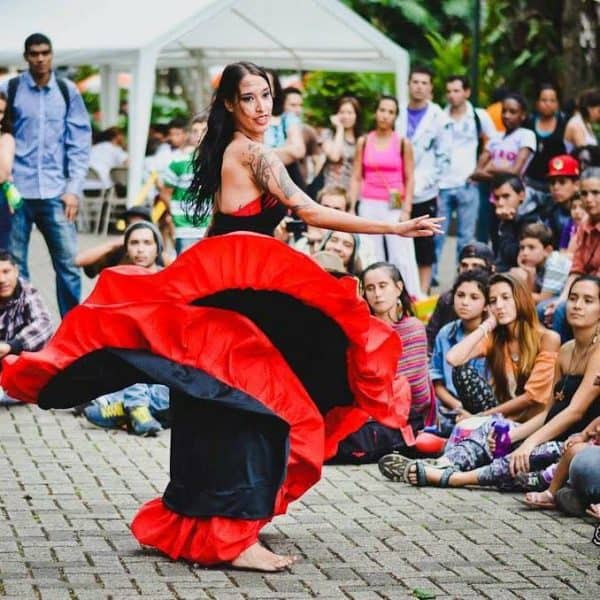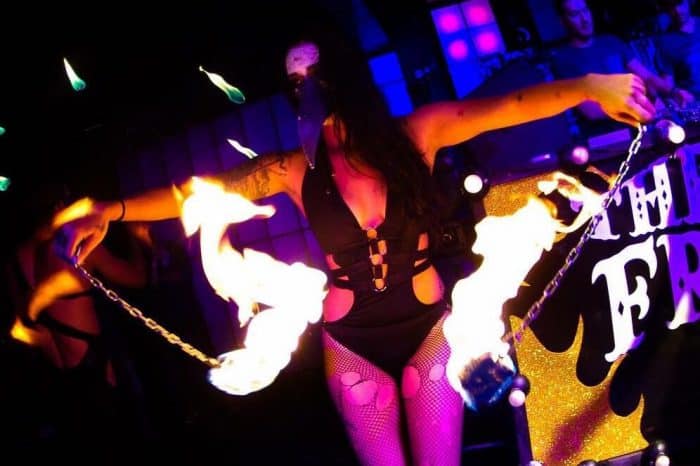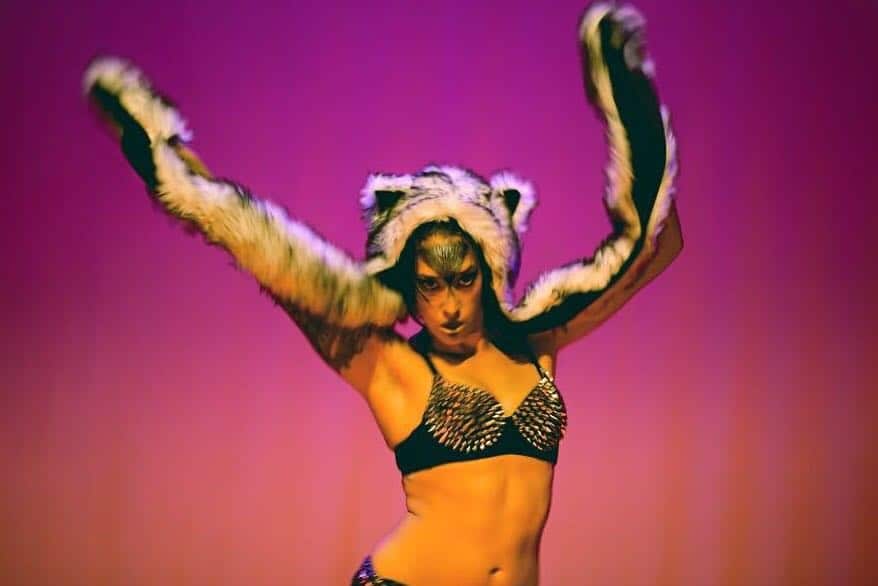Vanessa Messeguer, 33, is a dancer with a dizzying array of styles at her command: she practices Tribal Fusion Style, Improvisation Tribal Style, American Tribal Style, belly dance, pole dancing and fire shows, among many others. At the moment, she is the only certified Improvisation Tribal Style teacher in Central America. She teaches tribal dance at Aidah Manaar Academy, and pole dancing and what she describes as sexy style at Glo Studio Academy, soon to expand to Da Corpo Academy as well. She has also given workshops all around the country, and is producer and artistic director of Circo de La Luna.
American Tribal Style is a derivation of belly dancing that, instead of being an individual performance, seeks to make it group performance, a tribe of dancers expressing one common voice. At present, Messeguer is part of a group with three other leaders of the Improvisation Fusion Style in Costa Rica (María Campos, Paula Campos, and Pilar Quesada), who are rehearsing at Tierra Fertil Academy and will debut at the Flower Hips Festival in April.
The Tico Times visited Tierra Fertil Academy to talk to Messeguer about her career. Excerpts follow.
How did you become a dancer?
I have been dancing since I was 3 years old: modern dance and ballet. I graduated from Castella High School. At first, I was studying dance, but then I changed to theater, which actually has helped me a lot with my career. After I finished high school, I started working with an independent [modern dance] group called “Metamorfosis” which is where I fell in love with belly dancing.
At time there were very few belly-dancing teachers here [in Costa Rica] and I really wanted to learn. When I found my teacher, Ericka Zayas-Bazan, it was like love at first sight between both of us. I told her I practiced juggling with fire, and she told me she was interested in working with me because she worked with fire too and wanted to make a group of dancers performing with fire. She trained me, for free, for many years. And, it was because of her that I found the American Tribal Style. Once, Caro Dumanni, who is the best performers in tribal, organized a tribal dance festival and invited great dancers, there was where I met my current teacher, Amy Sigil. When I saw Amy dancing, I fall in love with her dancing.

How could you describe your dancing style?
My idea has always been to create my own style. I’ve taken Flamenco classes, tap, belly dancing; at some point what I wanted was to get all those dances together and create my own style. There’s when I found tribal, which actually is the dance that opens those doors to create new styles. When I met Amy Sigil, I saw her tribal style, and it’s really different. She mixes it with hip hop and modern dance, with a strong personality on the stage, and I really liked it. So, I started taking classes with her. Anytime she came to Costa Rica I took every single workshop with her.
I really like one of the fusion style branches called Gothic Fusion Style. It is darker: the music, the costumes, movements, makeup. I focus more on the sexy style, like a dark sexy style.
What made you fall in love with tribal dance?
The concept behind it, the philosophy. A women’s empowerment philosophy. Between women we support each other, we are together, we are sisters, and go along with each other. Besides, the fact that most of the girls have tattoos, dress in black, like all dark, when I saw that I thought, “This is my place.” And, that aspect, women’s empowerment and the power of girls, that made fall in love with it.
Dancing has a lot of benefits, any kind of dancing. It helps with coordination, which is amazing, also helps you improve your cardio, blood circulation, lose weight. Belly dancing, specifically, helps you a lot with your femininity. As you move your hips a lot and all the chakras located in that area, it helps improve digestion, femininity, self-esteem, menstrual pain, empowerment. This dance really helps to empower women and make them stronger. That’s what I love and what I always try to transmit with my classes. Nowadays, women are still lagging behind, but, this dance actually empowers us, besides all the other physical benefits. Also, it really helps girls who had been raped. It helps them get over those issues.
What does it mean to be a successful dancer?
To me, it means to love what you do and that when you express it to people, they can appreciate it. It’s different to be a successful dancer than to be a successful teacher.
I’m the only Improvisation Tribal Style teacher in Central America. The only person who can certify a teacher is the inventor of this style, who is Amy Sigil. To apply you have to take the teacher training in the United States, and then present your exam online. She tells you what you need to improve, so you can present your exam again, or if you do it perfectly on the first try then she can certify you. I did the teacher training in May 2015, and got my certification in October.
But as a successful dancer, [the main thing is to] really love to be onstage and transmit it. The most important thing is to love the dance. The passion, the devotion, the practice. Because not only the passion will make a good dancer, you have to work hard, train hard. The passion goes hand-in-hand with hard training to really be successful.

How does your circus work?
The Circus started in 2007 [with three women]. We started working with fire, belly dancing, aerial silks. When I was part of the group Metamorphosis, people called me to perform at shows, but they also used to ask me to take another artist with me for a different type of performance. So I thought I had to do something because they were [suggesting that I function as] a producer. I thought it would be a good idea for the future, because I won’t be able to dance for the rest of my life, to earn money as a performer.
So, that’s why I got more into the production [with the Circus]. I have already worked for really good brands, have worked for many clubs too. I was the director of Dolce Agency, so that opened many doors. I work for Club Vertigo; I do a lot of performances there and create productions for them. I also work for Jogo Production, with Noe Chavarría, Circo Vivo, Rodrigo Piedra.
At the beginning I did auditions and had a group of approximately 20 people. I chose people who were good but weren’t professionals; it was really nice group we did amazing projects. Now, most of them are professionals. I do not say it’s all my merit, because it’s not… but I brought them into that world, to start with their performances.
I also worked with many street artists, but it didn’t work out. We couldn’t agree on many things, so I stopped having groups and started working with professionals whom I call only when I need them.
Our “Weekend Arts Spotlight” presents Sunday interviews with artists who are from, working in, or inspired by Costa Rica, ranging from writers and actors to dancers and musicians. Do you know of an artist we should consider, whether a long-time favorite or an up-and-comer? Email us at kstanley@ticotimes.net.






